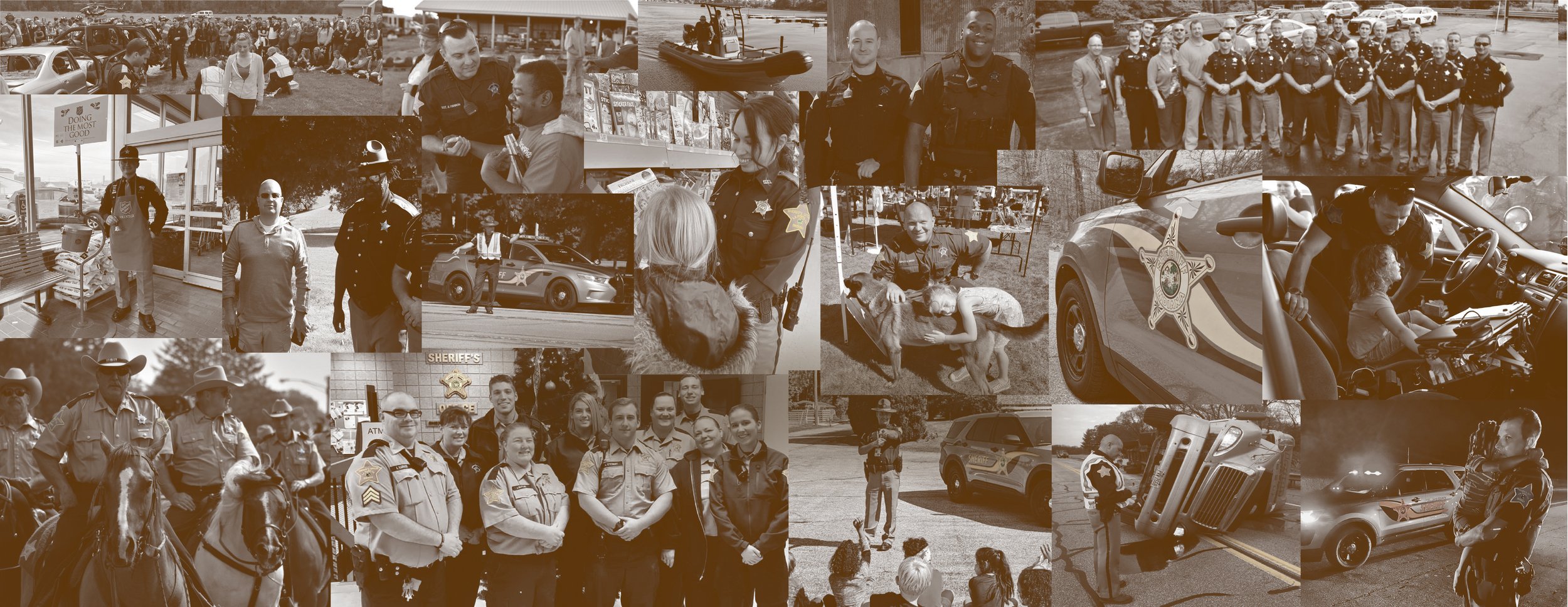
WHAT IS A SHERIFF?
While most people in America recognize the Sheriff as the chief law enforcement for the county, they would be surprised to know that the office of Sheriff has a proud history that spans well over a thousand years, from the early Middle Ages to our own "high-tech" era.
THE BEGINNING: THE MIDDLE AGES
More than 1,300 years ago in England, small groups of Anglo-Saxons lived in rural communities like modern day towns. Often at war, they decided to better organize themselves for defense. Sometime before the year 700, they formed a system of local self-government based on groups of ten.
Each of the towns divided into groups of ten families, called tithings. Each tithing elected a leader called a tithingman. The next level of government was a group of ten tithings (or 100 families), and this group elected its own chief. The Anglo-Saxon word for chief was gerefa, later shortened to reeve.
During the next two centuries, groups of hundreds banded together to form a new, higher unit of government called the shire. The shire was the forerunner of the modern county. Each shire had a chief (reeve) as well, and the more powerful official became known as a shire-reeve. The word shire-reeve became the modern English word Sheriff—the chief of the county.
The Sheriff maintained law and order within his own county with the assistance of the citizens. When the Sheriff sounded the ‘hue and cry’ that a criminal was at-large, anyone who heard the alarm was responsible for bringing the criminal to justice. This principle of citizen participation survives today in the procedure known as posse comitatus.
THE OFFICE GROWS
English government eventually became more centralized under the power of a single ruler, the king. The king distributed huge tracts of land to noblemen, who governed the land under the king's authority. The office of Sheriff was no longer elected but appointed by the noblemen for the counties they controlled. In those areas not consigned to noblemen, the king appointed his own Sheriffs.
After the Battle of Hastings in 1066, England’s rule fell to the Normans (France) who seized and centralized all power under the Norman king and his appointees. The Sheriff became the agent of the king, and among his new duties was tax collection.
This dictatorial rule by a series of powerful kings became intolerable, and in 1215, an army of rebellious noblemen forced the despotic King John to sign the Magna Carta. This important document restored several rights to the noblemen and guaranteed certain basic freedoms. The text of the Magna Carta mentioned the important role of the Sheriff nine times.
Over the next few centuries, the Sheriff remained the leading law enforcement officer of the county. It was an honor to be appointed Sheriff, but it was costly. If the people of the county did not pay the full amount of their taxes and fines, the Sheriff was required to make up the difference out of his own pocket. He also had to provide lavish entertainment for judges and visiting dignitaries at his own expense.
THE SHERIFF CROSSES THE ATLANTIC
The first American counties were established in Virginia in 1634, and records show that one of these counties elected a Sheriff in 1651. Most other colonial Sheriffs were appointed. Just as the noblemen in medieval England, large American landowners appointed Sheriffs to enforce the law in the areas they controlled and to protect their lands. American Sheriffs were not expected to pay extraordinary expenses, however, and some made money from the job.
Throughout the eighteenth and nineteenth centuries, colonial and state legislatures assigned a broad range of responsibilities to the Sheriff which included the familiar role of law enforcement and tax collection. Other duties were new, such as overseeing jails, houses of corrections and workhouses.
As Americans moved westward, so did the office of Sheriff and the use of jails. Settlers desperately needed the Sheriff to establish order in the lawless territories where power belonged to those with the fastest draw and the most accurate shot. Most western Sheriffs, however, kept the peace by virtue of their authority. With a few exceptions, Sheriffs resorted to firepower much less often than we have seen depicted in movies and on TV.
THE SHERIFF TODAY
There are over 3,000 counties in the United States, and almost every one of them has a Sheriff, except for Alaska. Some cities, such as Denver, St. Louis, Richmond, and Baltimore, have Sheriffs as well. The office of Sheriff is established either by the state constitution or by an act of state legislature. There are only two states in which the Sheriff is not elected by the voters. In Rhode Island, Sheriffs are appointed by the governor; in Hawaii, deputy Sheriffs serve in the Department of Public Safety's Sheriff's Division.
There is really no such thing as a "typical" Sheriff. Some Sheriffs still have time to drop by the town coffee shop to chat with the citizens each day, while others report to an office in a skyscraper and manage a department whose budget exceeds that of many corporations. However, most Sheriffs have certain roles and responsibilities in common.
Law Enforcement. A Sheriff always has the power to make arrests within his or her own county. Some states extend this authority to adjacent counties or to the entire state. Many Sheriffs' offices also perform routine patrol functions such as traffic control, accident investigations, and transportation of prisoners. Larger departments may perform criminal investigations, and some unusually large Sheriffs' offices command an air patrol, a mounted patrol, or a marine patrol.
Sheriffs still enlist the aid of the citizens. The National Neighborhood Watch Program, sponsored by the National Sheriffs' Association, allows citizens and law enforcement officials to cooperate in keeping communities safe.
As the Sheriff's law enforcement duties become more extensive and complex, new career opportunities exist for people with specialized skills: underwater diving, piloting, boating, skiing, radar technology, communications, computer technology, accounting, emergency medicine, and foreign languages (especially Spanish, French, and Vietnamese.)
Court Duties. Sheriffs are responsible for maintaining the safety and security of the court. A Sheriff or deputy may be required to attend all court sessions; to act as bailiff; to take charge of juries whenever they are outside the courtroom; to serve court papers; to extradite prisoners; to collect taxes, or to perform other court-related functions.
Jail Administration. Most Sheriffs' offices maintain and operate county jails or other detention centers and community corrections facilities such as work-release and halfway houses. Sheriffs are responsible for supervising inmates, protecting their rights, and providing food, clothing, exercise, recreation, and medical services. As jail conditions continue to improve, Sheriffs and their departments are earning increased respect and recognition as professionals.
Law enforcement is becoming increasingly complex. For the progressive, forward-looking Sheriffs' offices of today, education and training are the keys to effective job performance.
Please visit the Indiana Sheriffs’ Association website for more detailed information.


